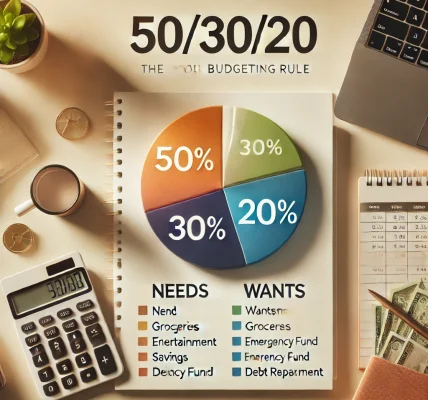Managing finances doesn’t always require making drastic changes. Sometimes, it’s the small, consistent adjustments that make the biggest impact over time. This is where micro-budgeting comes in—a strategy that focuses on making small, intentional changes to spending habits to save money and build financial stability.
In this article, we’ll explore the concept of micro-budgeting, its benefits, practical tips to apply it, and how these small changes can lead to big savings over time.
What is Micro-Budgeting?
Micro-budgeting is a budgeting method that involves tracking and optimizing small, everyday expenses to gradually reduce spending and increase savings. Instead of overhauling your entire financial plan, micro-budgeting encourages making incremental changes that add up over time.
How is Micro-Budgeting Different?
Unlike traditional budgeting, which often focuses on broad expense categories (such as rent, groceries, and transportation), micro-budgeting narrows the focus to smaller, overlooked expenses—like daily coffee runs, subscription services, and impulse purchases.
Why Micro-Budgeting Works
1. Easy to Implement and Maintain
Micro-budgeting is less overwhelming than a complete financial overhaul. By focusing on small, manageable changes, it’s easier to stay consistent and build better spending habits.
2. Creates Awareness of Hidden Expenses
Many small expenses go unnoticed but can add up significantly over time. Micro-budgeting helps identify and eliminate these expenses, freeing up money for more meaningful financial goals.
3. Promotes Long-Term Financial Stability
Consistently saving small amounts can lead to significant savings over time. This method makes it easier to build an emergency fund, pay off debt, and invest in the future.
Small Changes That Lead to Big Savings
1. Cut Down on Subscription Services
Many people sign up for multiple subscription services, from streaming platforms to fitness apps, without realizing how much they are spending monthly. Review your subscriptions and cancel any that you no longer use or need.
🔹 Pro Tip: Use a subscription management app like Truebill or Trim to track and manage recurring payments.
2. Bring Your Own Coffee or Lunch
Buying coffee or lunch daily can cost hundreds of dollars per month. Preparing your own coffee and meals can save a significant amount over time.
🔹 Savings Impact: Cutting out a $5 coffee every weekday saves around $100 per month or $1,200 per year.
3. Utilize Cashback and Discount Apps
Use cashback and coupon apps like Rakuten, Honey, or Ibotta to get discounts and earn money back on everyday purchases.
🔹 Pro Tip: Combine cashback with credit card rewards for even greater savings.
4. Automate Savings with Round-Up Apps
Round-up apps like Acorns or Qapital automatically round up your purchases to the nearest dollar and invest or save the spare change. These micro-savings grow over time without much effort.
🔹 Savings Impact: Rounding up an average of $0.50 per purchase can add up to $15–$30 per month, depending on how often you spend.
5. Use Energy-Efficient Appliances and Habits
Reducing energy consumption not only lowers utility bills but also helps the environment. Switch to energy-efficient appliances and develop habits like turning off lights and unplugging devices.
🔹 Savings Impact: Lowering your energy usage can save $20–$50 per month.
6. Negotiate Your Bills
Many service providers, including internet, phone, and insurance companies, offer discounts or better rates if you negotiate. Call your service providers and inquire about promotions or loyalty discounts.
🔹 Pro Tip: If negotiating is not your strong suit, services like Billshark and Trim can negotiate on your behalf.
7. Switch to Generic Brands
Opting for store-brand or generic products instead of name brands can lead to substantial savings over time, especially for groceries and household items.
🔹 Savings Impact: Switching to generic products can cut grocery bills by 10–30%.
8. Limit Impulse Purchases
Impulse buying can significantly derail your budget. Practice a 24-hour rule where you wait a day before making non-essential purchases. This delay helps assess whether the item is a need or a want.
🔹 Pro Tip: Use a wish list to track items and revisit them after a few days to see if you still want them.
Creating a Micro-Budgeting Plan
Step 1: Identify Small Expenses
Track your spending for a month and identify small, recurring expenses that can be reduced or eliminated. Focus on expenses that don’t add significant value to your life.
Step 2: Set Micro-Savings Goals
Set specific and measurable micro-savings goals, such as saving an extra $50 a month or reducing dining-out expenses by 20%.
Step 3: Implement One Change at a Time
Start with one small change and gradually introduce more adjustments. Taking it one step at a time makes it easier to develop long-lasting habits.
Step 4: Track Progress and Celebrate Wins
Track your progress to stay motivated and celebrate small wins. Seeing how micro-changes accumulate over time reinforces positive habits.
Common Mistakes to Avoid
1. Trying to Change Too Much at Once
Making too many changes simultaneously can be overwhelming. Focus on one or two adjustments before adding more.
2. Not Tracking Progress
Failing to monitor your progress makes it difficult to stay motivated. Use budgeting apps to keep track of your savings.
3. Giving Up Too Soon
Micro-budgeting takes time to show results. Be patient and stay consistent, even if the impact isn’t immediately visible.
Benefits of Micro-Budgeting
1. Increased Savings Without Sacrifice
By making small adjustments, you can accumulate significant savings without feeling deprived.
2. Improved Financial Discipline
Micro-budgeting helps develop better spending habits and improves financial discipline over time.
3. Greater Financial Awareness
Tracking small expenses increases awareness of spending patterns, empowering you to make informed financial decisions.
Conclusion
Micro-budgeting is a powerful strategy that leverages small, manageable changes to achieve significant financial gains over time. By identifying and eliminating unnecessary expenses, automating savings, and developing mindful spending habits, you can take control of your finances and work toward a more secure financial future.
Start today by implementing one small change and watch your savings grow. Remember, small steps lead to big results!




